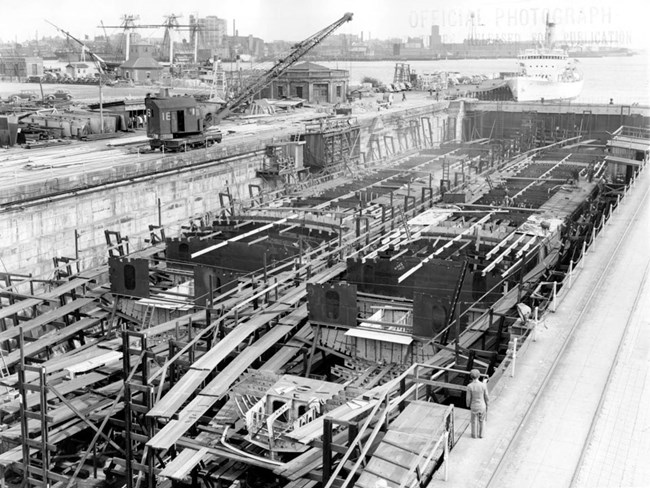
14 Apr 2021 Preserving Shipbuilding History in a Growing Charlestown Navy Yard
Three proposals from private developers for the redevelopment of Pier 5 in the Charlestown Navy Yard are under review by the Boston Planning and Development Agency for new housing and recreational opportunities.
Historic Boston Inc. is part of the developer Urbanica’s team, which proposes to build 89 income-restricted apartments on the pier surrounded by a public promenade. A park at the the far end of the pier will provide the public with recreational opportunities in the summer and a skating rink in the winter. The new buildings on the pier will also have a green roof of community gardens that are accessible to the public, and the development proposes additional sailing slips for the Courageous Sailing Center which is currently located on Pier 4.
The Charlestown Navy Yard is one of the nation’s oldest ship building facilities. Begun in 1801 for the recently constituted United States Navy, Boston’s Navy Yard was one of the most important in the young United States and would remain so into the 20th century. During World War two along, 6000 ships were built, repaired or launched out of the Navy Yard. The US Navy decommissioned the Navy Yard in 1974 and, although it now offers an array of public and private uses such as the historic USS Constitution, museums and hotels, and important medical and research facilities, the gray granite buildings, piers and dry docks are reminders of Boston’s rich maritime history.
Any one of the proposed plans will transform Pier 5 into a dense development of modern buildings. But one tiny structure – Building 123, also known as the Pumphouse – will remain along the drydock’s edge to help tell the story of the Navy Yard’s ship building history. The Pumphouse is a small round single-story structure built along with Drydock #2 in 1905 to manage water flow in and out of the massive Drydock #2 nestled between Pier’s 4 and 5.
Drydock #2 was a large basin with a caisson at the far end that would form a barrier to prevent water from entering the drydock. A ship built within the enclosed drydock could be launched by pumping water into the drydock until the ship floated, and then removing the caisson. A ship could also be brought into the flooded drydock for repairs, requiring that water be pumped out of the enclosed space once the ship was secured. The pumps that made these actions possible were enclosed within the small neo-classical Pumphouse in Building 123, and operated from 1905 until the Navy Yard closed in 1974.
Should Urbanica be designated developer of Pier 5, Historic Boston will assist with plans to restore the Pumphouse and re-activate it for public uses. Our plans call for the building to include an interpretive center that will help to tell the Navy Yard’s story, and Pier 5’s extraordinary shipbuilding role.





